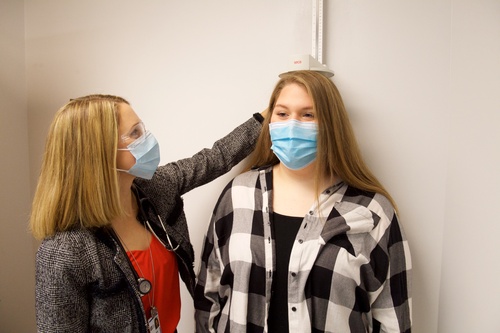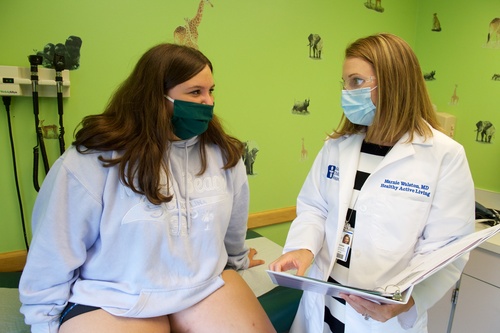
Physicians check body mass index (BMI) at routine well visits to track a child’s growth pattern over time. BMI can help your health care provider identify if your child or teen is gaining weight too slowly or too quickly and whether it’s a normal part of development or something to be concerned about.
BMI stands for Body Mass Index. It is a measurement of a person’s weight divided by the square of their height which is used to estimate how much body fat someone has. Physicians check BMI at routine well visits to track a child’s growth pattern over time.
According to Dr. Marnie Walston, pediatrician, and medical director of the Healthy Active Living Program at Akron Children’s, BMI is an important screening tool for health care providers because it’s quick and inexpensive and gives helpful information on health risk. However, she cautions it also has its limitations because it doesn’t actually measure body fat – which is the factor that increases the risk for diseases, like diabetes.
“Some people with a high BMI may not actually have an unhealthy amount of body fat. Muscular athletes are a good example,” she says.
Teens can have a high BMI if they have a large frame or a lot of muscle. Conversely, a person with a small frame may have a normal BMI but still have too much body fat.
“It’s common for teens to gain weight quickly during puberty which causes their BMI to go up,” says Dr. Walston. “If a child’s BMI is too high or too low, this should prompt a conversation with your pediatrician about their overall health and health risks.”
BMI alone does not diagnose a health problem, but it can be a clue about other things going on. There are health risks associated with being overweight and being underweight. If BMI is too high, additional tests may be recommended to screen for diseases associated with having an unhealthy amount of body fat.

Dr. Marnie Walston, medical director of the Healthy Active Living Program
“These diseases include things like type 2 diabetes, high blood pressure, high cholesterol and fatty liver disease. People with an unhealthy amount of body fat are at increased risk for heart disease, cancer and joint issues,” says Dr. Walston.
Dr. Walston adds that it’s important to look at BMI as a trend instead of focusing on individual numbers.
“Any one measurement, taken out of context, can give you the wrong impression of your child’s growth,” she says.
BMI percentiles show how a child’s measurements compare with others the same gender and age. For example, if a child has a BMI in the 60th percentile, 60% of the kids of the same gender and age who were measured had a lower BMI.
The categories typically used to describe a child’s weight are:
- Underweight: BMI is below the 5th percentile for age and gender.
- Healthy weight: BMI is equal to or greater than the 5th percentile and less than the 85th percentile for age and gender.
- Overweight: BMI is at or above the 85th percentile but less than the 95th percentile for age and gender.
- Obesity: BMI is at or above the 95th percentile for age and gender.
One of the issues with BMI screening is that it doesn’t consider a person’s race and ethnicity or environmental or lifestyle factors which can vary among populations. Although it’s not perfect, BMI can help your pediatrician identify if your child or teen is gaining weight too slowly or too quickly and whether it’s a normal part of development or something to be concerned about.

If your child’s BMI is too high or too low, this should prompt a conversation with your pediatrician about their overall well-being and health risks.
Here are some tips to help kids maintain a healthy weight:
- Encourage kids to be active every day. Experts recommend that kids get 60 minutes or more of physical activity daily.
- Offer fruits and vegetables at meals and snacks and encourage your child to eat 5 or more servings a day.
- Serve the right portion sizes for your child’s age.
- Limit sugar-sweetened beverages and offer low-fat milk or water instead.
- Limit screen time (watching TV, playing video games, using a smartphone, computer, or other device) to less than 2 hours a day.
- Set a good example by eating healthy, being physically active, and limiting the time you spend in front of a screen.
The Healthy Active Living program at Akron Children’s provides comprehensive evaluation and treatment for children and teens with more serious weight-related issues. Our team includes a physician who specializes on obesity medicine, psychologist, certified nurse practitioner, dietitian and exercise physiologist.
Interested in learning more? Call 330-543-5673 for more information.










